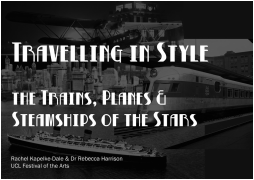 Earlier in the year a call went out for UCL academics to participate in the UCL Festival of the Arts, an annual showcase of research in the Arts and Humanities held every May. I had considered applying before (I’m always happy to get involved in outreach initiatives) but was put off by the prospect of leading a public lecture on my own. Having co-taught the ‘Reading and Researching Film’ module on the UCL Film Studies programme with my colleague Rachel before Christmas, it occurred to me that I might not have to apply alone. We have similar research interests (I investigate cinema and transport, and Rachel examines European film stars travelling to Hollywood in the 1930s), and our co-teaching was successful, so we decided to work together on a joint lecture. Coming up with an abstract was an easy enough endeavour. We decided to draw on both our research projects and explore the significance of transport in constructing stardom in the 30s and 40s, with Rachel focusing on Hollywood actors and me drawing on stories about British celebrities. Our abstract was incredibly vague: with both of us busy writing other papers and articles, we simply synthesised our research, threw in some key terms (‘gender’ and ‘performance’) and hoped for the best. Fortunately, our idea was accepted and we were chosen to present ‘Travelling in Style – the Trains, Planes and Steamships of the Stars’. That’s when the real work began… Inevitably, refining the topic, deciding on case studies and actually writing a joint lecture was not as straightforward as our abstract. Here, I have summarised some of the challenges, as well as the advantages, we came across when working together. Challenges Refining the topic When we seriously began refining the topic two things happened. First, we got bogged down in detail. In attempting to come up with interesting case studies we lost sight of the broader themes we discussed—gender, performance, national identity—and tried too hard to find examples from the US and the UK that told the same story. We were overly concerned about the specifics of how our projects intersected. Second, we went too broad. We discussed more and more examples and ever-wider timeframes in a bid to create an all-encompassing history of film stars and transport. Eventually, we decided to work on one case study each for the three different types of transport in our title – trains, planes and ships. Creating a coherent narrative Our next challenge was to come up with a coherent lecture that linked all six case studies and took our (largely public) audience on a journey that made sense from a narrative perspective. We decided the best way to tackle this was to get all our research in place and to have regular discussions about our findings. We compared timelines and themes to establish chronology and an over-arching argument. Linking sections and ideas When writing up our individual sections of the lecture we had a good sense of one another’s research and findings. However, it took much longer than we anticipated for us to link our ideas. We rehearsed the lecture through multiple times and made copious notes on the materials and themes in each section to help us tease out the connections between our projects. Not only did this enable us to segue neatly between topics, but also gave us the opportunity to cross-reference one another and interweave different parts of our individual research in the other’s sections. When we came to present the lecture it felt like a joint, rather than just a shared, effort. Advantages Comparative work By the time we presented both of us had learned a great deal about one another’s research, in terms of methodology, interests and historical detail. Each of us gained almost as much from the lecture as the audience did through undertaking comparative work. Given that we work on similar periods, expanding our knowledge transatlantically benefited both of our projects. Confidence and teamwork Preparing a lecture can be time-consuming and presenting one can be nerve-wracking. While co-presenting created challenges (for example, editing the different sections took longer than it might have done for a single-authored paper) the overall experience was positive. Knowing that Rachel would be standing beside me throughout the lecture gave me greater confidence, as I knew we had a shared responsibility to our audience. Additionally, the writing process was in many ways easier because I had someone to bounce my ideas off and help me to refine my research. Dynamic presentation Engaging an academic audience for twenty minutes during an academic conference can be challenging. Anyone who presents at conferences dreads yawns, entrances and exits mid-way through papers and the increasing presence of smart phones. The prospect of entertaining a public audience for forty-five minutes is necessarily more terrifying. By co-presenting, we avoided many of the pitfalls of a dull presentation. We used Prezi for all our images and cued one another’s clips to make the lecture as slick as possible. (NB. Not only does Prezi looks more exciting than PowerPoint, it can be edited online by multiple users, making it a great choice for joint lectures - you can view our Prezi here.). And we also switched back and forth as speakers as we gave our examples, which kept things changing, and thus more engaging, for the audience. Often in academia we work in isolated bubbles and communicate little with our colleagues about our actual research. Writing and presenting a joint lecture was a great way to learn more about Rachel’s project, share my own and gain insights into collaborative work.
2 Comments
Leave a Reply. |
BlogArchives
November 2018
Categories
All
|
 RSS Feed
RSS Feed